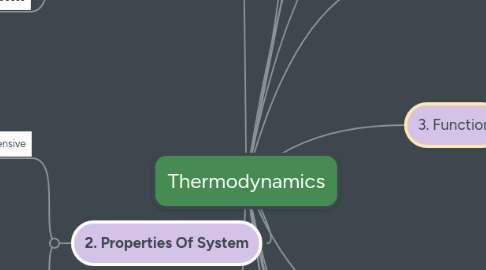
1. 2. Properties Of System
1.1. i. Extensive
1.1.1. Dependent on Matter
1.1.1.1. Heat capacity
1.1.1.2. Mass
1.1.1.3. Volume
1.1.1.4. Internal Energy
1.2. ii. Intensive
1.2.1. Independent of Matter
1.2.1.1. Density
1.2.1.2. Pressure
1.2.1.3. Viscosity
1.2.1.4. Temperature
1.2.1.5. Melting and boiling point
1.2.1.6. Specific Heat
2. 4. Thermodynamic Process
2.1. i. Isothermal Process
2.1.1. ∆T = Constant ∆V = 0 Q = -W
2.2. ii. Isobaric Process
2.2.1. Pressure = Constant ∆P =0 ∆U = QP - Pex∆V
2.3. iii. Isochoric Process
2.3.1. Volume = Constant ∆U = Q
2.4. iv. Adiabatic Process
2.4.1. No heat exchange
2.4.1.1. ∆Q = 0 ∆U = W
3. 7. Sign Conventions
3.1. +Q : Heat from surrounding to system
3.2. -Q : Heat from system to surrounding
3.3. +W : Work done on system by surrounding
3.4. -W : Work done on surrounding by system
4. 6. Nature of Heat and Work
4.1. i. Work
4.1.1. It is work done when system expands or contracts against external opposing force
4.1.1.1. W = PV = fd
4.2. ii. Heat = Q
4.2.1. It is energy by which system exchanges energy with surrounding
4.3. iii. Expression of PV work
4.3.1. W = -Pex (V2 - V1)
4.4. iv. Expression for max work
4.4.1. Wmax = -2.303 nRT log (V2/V1) Or Wmax =-2.303 nRT log (P1/P2)
5. 10. First Law of Thermodynamics
5.1. Total energy of system and surrounding remains constant when system changes from initial state to final state
5.2. Mathematical Expression ∆U = Q+W
6. 12. Enthalpy of Physical Transformation
6.1. i. Enthalpy of fusion [ ∆fus H]
6.1.1. Enthalpy at change from solid to liquid at constant temperature and pressure
6.2. ii.Enthalpy of vaporization. [∆vap H]
6.2.1. Enthalpy of change from liquid to vapour
6.3. iii. Enthalpy of Sublimation [∆sub H]
6.3.1. Enthalpy of direct change from solid to vapour
6.4. iv. Enthalpy of Ionisation [∆ion H]
6.4.1. Enthalpy change for removal of electron from 1 mole of gas atom
6.5. v. Electron Gain Enthalpy [∆eg H]
6.5.1. Enthalpy change for accepting electron by 1 mole of gas
6.6. vi. Enthalpy of atomisation [∆atom H]
6.6.1. Enthalpy change dissociation of 1 mole of gas in atoms
6.7. vii. Enthalpy of Solution [∆sol H]
6.7.1. Enthalpy change when 1 mole of substance dissolved in specific amount of solvent.
6.8. viii. Enthalpy of Chemical reaction[∆r H]
6.8.1. ∆rH = summation Hproducts - summation Hreactants
6.9. ix. Standard Enthalpy of Formation
6.9.1. Enthalpy change during reaction on which 1 mole of pure compound in its standard state is formed from elements in standard state.
6.10. x. Standard Enthalpy of combustion
6.10.1. Enthalpy change during reaction in which 1mole of substance in its standard state is completely oxidised
6.10.2. C2H2 (g) + 5/2O2 ---> 2CO2 (g) + H2O (l) ∆rH° = -1300KJ
6.11. xi. Bond Enthalpy
6.11.1. Enthalpy change required to break covalent bond in 1 mole of gaseous molecules to produce atoms
6.11.2. H2 ----> H(g) + H(g). ∆rH° = 436.4 KJ
7. 14. Entropy
7.1. It's measure of randomness or disorder
8. 1. System
8.1. i. Open
8.1.1. Mass ✓ Heat ✓
8.1.2. Example : Open Cup
8.2. ii. Closed
8.2.1. Mass ❌ Heat ✓
8.2.2. Example : Closed cup
8.3. iii. Isolated
8.3.1. Mass ❌ Heat ❌
8.3.2. Example : Thermos
9. 3. Function
9.1. i. State
9.1.1. Independent of path
9.1.1.1. Temperature
9.1.1.2. Pressure
9.1.1.3. Volume
9.2. ii. Path
9.2.1. Dependent on path
9.2.1.1. Work
9.2.1.2. Heat
10. 8. Thermodynamic Equilibrium
10.1. Pressure and Volume changes But Temperature is constant
11. 5. Reversible Process
11.1. Driving force > Opposing Force
12. 9. Internal Energy (U)
12.1. Energy which is stored in substance
13. 11. Enthalpy
13.1. H = U + PV ∆H = ∆U + P∆V
13.1.1. Relation between ∆H and ∆U
13.1.1.1. ∆H = ∆U + ∆ngRT
13.1.2. Work Done in chemical reaction
13.1.2.1. W = -∆ngRT
